Dynamic Characterization of the Human Heme Nitric Oxide/Oxygen (HNOX) Domain under the Influence of Diatomic Gaseous Ligands
Abstract
1. Introduction
2. Results and Discussion
2.1. Homology Modeling
2.2. QM Calculations
2.3. MD Stability Analysis
2.4. Hydrogen Bond Occurrence
2.5. Essential Dynamics
3. Materials and Methods
3.1. Comparative Modeling of Human sGC HNOX Domain
3.2. QM/MM Calculations
3.3. MD Simulations
3.4. Hydrogen Bond Occupancy
3.5. Principal Component Analysis (PCA)
4. Conclusions
Author Contributions
Funding
Acknowledgments
Conflicts of Interest
References
- Pyriochou, A.; Papapetropoulos, A. Soluble guanylyl cyclase: More secrets revealed. Cell Signal. 2005. [CrossRef] [PubMed]
- Beste, K.Y.; Spangler, C.M.; Burhenne, H.; Koch, K.W.; Shen, Y.; Tang, W.J.; Kaever, V.; Seifert, R. Nucleotidyl Cyclase Activity of Particulate Guanylyl Cyclase A: Comparison with Particulate Guanylyl Cyclases E and F, Soluble Guanylyl Cyclase and Bacterial Adenylyl Cyclases Cyaa and Edema Factor. PLoS ONE 2013, 8. [Google Scholar] [CrossRef] [PubMed]
- Campbell, M.G.; Underbakke, E.S.; Potter, C.S.; Carragher, B.; Marletta, M.A. Single-particle EM reveals the higher-order domain architecture of soluble guanylate cyclase. Proc. Natl. Acad. Sci. USA 2014, 111, 2960–2965. [Google Scholar] [CrossRef]
- Jain, R.; Chan, M.K. Mechanisms of ligand discrimination by heme proteins. J. Biol. Inorg. Chem. 2003, 8, 1–11. [Google Scholar] [CrossRef] [PubMed]
- Friebe, A.; Koesling, D. Regulation of nitric oxide-sensitive guanylyl cyclase. Circ. Res. 2003, 93, 96–105. [Google Scholar] [CrossRef] [PubMed]
- Ma, X.; Sayed, N.; Beuve, A.; Van Den Akker, F. NO and CO differentially activate soluble guanylyl cyclase via a heme pivot-bend mechanism. EMBO J. 2007, 26, 578–588. [Google Scholar] [CrossRef] [PubMed]
- Pellicena, P.; Karow, D.S.; Boon, E.M.; Marletta, M.A.; Kuriyan, J. Crystal structure of an oxygen-binding heme domain related to soluble guanylate cyclases. Proc. Natl. Acad. Sci. USA 2004, 101, 12854–12859. [Google Scholar] [CrossRef]
- Bikiel, D.E.; Boechi, L.; Capece, L.; Crespo, A.; De Biase, P.M.; Di Lella, S.; González Lebrero, M.C.; Martí, M.a.; Nadra, A.D.; Perissinotti, L.L.; et al. Modeling heme proteins using atomistic simulations. Phys. Chem. Chem. Phys. 2006, 8, 5611–5628. [Google Scholar] [CrossRef]
- Uchida, T.; Sato, E.; Sato, A.; Sagami, I.; Shimizu, T.; Kitagawa, T. CO-dependent activity-controlling mechanism of heme-containing CO-sensor protein, neuronal PAS domain protein 2. J. Biol. Chem. 2005, 280, 21358–21368. [Google Scholar] [CrossRef]
- Derbyshire, E.R.; Marletta, M.A. Biochemistry of Soluble Guanylate Cyclase. In cGMP: Generators, Effectors and Therapeutic Implications; Handbook of Experimental Pharmacology; Springer: Berlin/Heidelberg, Germany, 2009; Volume 191, pp. 17–32. [Google Scholar]
- Enemark, J.H.; Feltham, R.D. Principles of structure, bonding, and reactivity for metal nitrosyl complexes. Coord. Chem. Rev. 1974, 13, 339–406. [Google Scholar] [CrossRef]
- Karow, D.S.; Pan, D.; Tran, R.; Pellicena, P.; Presley, A.; Mathies, R.A.; Marletta, M.A. Spectroscopic characterization of the soluble guanylate cyclase-like heme domains from Vibrio cholerae and Thermoanaerobacter tengcongensis. Biochemistry 2004, 43, 10203–10211. [Google Scholar] [CrossRef] [PubMed]
- Ballou, D.P.; Zhao, Y.; Brandish, P.E.; Marletta, M.A. Revisiting the kinetics of nitric oxide (NO) binding to soluble guanylate cyclase: The simple NO-binding model is incorrect. Proc. Natl. Acad. Sci. USA 2002, 99, 12097–12101. [Google Scholar] [CrossRef] [PubMed]
- Frenking, G.; Fröhlich, N. The Nature of the Bonding in Transition-Metal Compounds. Chem. Rev. 2000, 100, 717–774. [Google Scholar] [CrossRef] [PubMed]
- Rovira, C.; Kunc, K.; Hutter, J.; Ballone, P.; Parrinello, M. Equilibrium geometries and electronic structure of iron-porphyrin complexes: A density functional study. J. Phys. Chem. A 1997, 101, 8914–8925. [Google Scholar] [CrossRef]
- Ellison, M.K.; Schulz, C.E.; Scheidt, W.R. Nitrosyliron(III) porphyrinates: Porphyrin core conformation and FeNO geometry. Any correlation? J. Am. Chem. Soc. 2002, 124, 13833–13841. [Google Scholar] [CrossRef]
- Zhang, Y.; Skolnick, J. Scoring function for automated assessment of protein structure template quality. Proteins Struct. Funct. Genet. 2004, 57, 702–710. [Google Scholar] [CrossRef] [PubMed]
- Li, P.; Merz, K.M. MCPB.py: A Python Based Metal Center Parameter Builder. J. Chem. Inf. Model. 2016, 56, 599–604. [Google Scholar] [CrossRef]
- Goddard, T.D.; Huang, C.C.; Ferrin, T.E. Visualizing density maps with UCSF Chimera. J. Struct. Biol. 2007, 157, 281–287. [Google Scholar] [CrossRef] [PubMed]
- Seminario, J.M. Calculation of intramolecular force fields from second-derivative tensors. Int. J. Quantum Chem. 1996, 60, 1271–1277. [Google Scholar] [CrossRef]
- Roe, D.R.; Cheatham, T.E. PTRAJ and CPPTRAJ: Software for processing and analysis of molecular dynamics trajectory data. J. Chem. Theory Comput. 2013, 9, 3084–3095. [Google Scholar] [CrossRef]
- Schelvis, J.P.M.; Seibold, S.A.; Cerda, J.F.; Garavito, R.M.; Babcock, G.T. Interaction of Nitric Oxide with Prostaglandin Endoperoxide H Synthase-1: Implications for Fe−His Bond Cleavage in Heme Proteins. J. Phys. Chem. B 2000, 104, 10844–10850. [Google Scholar] [CrossRef]
- Martí, M.A.; Capece, L.; Crespo, A.; Doctorovich, F.; Estrin, D.A. Nitric oxide interaction with cytochrome c’ and its relevance to guanylate cyclase. Why does the iron histidine bond break? J. Am. Chem. Soc. 2005, 127, 7721–7728. [Google Scholar] [CrossRef] [PubMed]
- Zhao, Y.; Brandish, P.; Ballou, D.; Marletta, M. A Molecular Basis for Nitric Oxide Sensing by Soluble Guanylate Cyclase. Proc. Natl. Acad. Sci. USA 1999, 96, 14753–14758. [Google Scholar] [CrossRef] [PubMed]
- Underbakke, E.S.; Iavarone, A.T.; Marletta, M.A. Higher-order interactions bridge the nitric oxide receptor and catalytic domains of soluble guanylate cyclase. Proc. Natl. Acad. Sci. USA 2013, 110, 6777–6782. [Google Scholar] [CrossRef] [PubMed]
- Laskowski, R.A.; Swindells, M.B. LigPlot+: Multiple ligand-protein interaction diagrams for drug discovery. J. Chem. Inf. Model. 2011. [Google Scholar] [CrossRef] [PubMed]
- Teeter, M.M.; Case, D.A. Harmonic and quasiharmonic descriptions of crambin. J. Phys. Chem. 1990, 94, 8091–8097. [Google Scholar] [CrossRef]
- Tai, K.; Shen, T.; Henchman, R.H.; Bourne, Y.; Marchot, P.; McCammon, J.A. Mechanism of acetylcholinesterase inhibition by fasciculin: A 5-ns molecular dynamics simulation. J. Am. Chem. Soc. 2002, 124, 6153–6161. [Google Scholar] [CrossRef]
- Stone, J.R.; Marletta, M.A. Spectral and kinetic studies on the activation of soluble guanylate cyclase by nitric oxide. Biochemistry 1996, 35, 1093–1099. [Google Scholar] [CrossRef]
- Capece, L.; Estrin, D.A.; Marti, M.A. Dynamical characterization of the heme NO oxygen binding (HNOX) domain. Insight into soluble guanylate cyclase allosteric transition. Biochemistry 2008, 47, 9416–9427. [Google Scholar] [CrossRef]
- Altschul, S.F.; Gish, W.; Miller, W.; Myers, E.W.; Lipman, D.J. Basic local alignment search tool. J. Mol. Biol. 1990. [Google Scholar] [CrossRef]
- Giuili, G.; Scholl, U.; Bulle, F.; Guellaën, G. Molecular cloning of the cDNAs coding for the two subunits of soluble guanylyl cyclase from human brain. FEBS Lett. 1992, 304, 83–88. [Google Scholar] [CrossRef]
- Webb, B.; Sali, A. Comparative protein structure modeling using MODELLER. Curr. Protoc. Bioinform. 2014, 2014, 5.6.1–5.6.32. [Google Scholar] [CrossRef]
- Lovell, S.C.; Davis, I.W.; Arendall, W.B.; de Bakker, P.I.W.; Word, J.M.; Prisant, M.G.; Richardson, J.S.; Richardson, D.C. Structure validation by Calpha geometry: Phi, psi and Cbeta deviation. Proteins 2003, 50, 437–450. [Google Scholar] [CrossRef]
- Krieger, E.; Koraimann, G.; Vriend, G. Increasing the precision of comparative models with YASARA NOVA—A self-parameterizing force field. Proteins Struct. Funct. Genet. 2002, 47, 393–402. [Google Scholar] [CrossRef] [PubMed]
- Chen, V.B.; Arendall, W.B.; Headd, J.J.; Keedy, D.A.; Immormino, R.M.; Kapral, G.J.; Murray, L.W.; Richardson, J.S.; Richardson, D.C. MolProbity: All-atom structure validation for macromolecular crystallography. Acta Crystallogr. Sect. D Biol. Crystallogr. 2010, 66, 12–21. [Google Scholar] [CrossRef] [PubMed]
- DeLano, W.L. The PyMOL Molecular Graphics System. San Carlos, CA, USA. 2002. Available online: http://www.pymol.org (accessed on 2 February 2019).
- Case, D.A.; Betz, R.M.; Botello-Smith, W.; Cerutti, D.S.; Cheatham, T.E., III; Darden, T.A., III; Duke, R.E.; Giese, T.J.; Gohlke, H.; Goetz, A.W.; et al. AMBER 2016, University of California, San Francisco; University of California: San Francisco, CA, USA, 2016. [Google Scholar]
- Tirado-Rives, J.; Jorgensen, W.L. Performance of B3LYP density functional methods for a large set of organic molecules. J. Chem. Theory Comput. 2008, 4, 297–306. [Google Scholar] [CrossRef]
- Chakravorty, D.K.; Wang, B.; Lee, C.W.; Giedroc, D.P.; Merz, K.M. Simulations of allosteric motions in the zinc sensor CzrA. J. Am. Chem. Soc. 2012, 134, 3367–3376. [Google Scholar] [CrossRef] [PubMed]
- Frisch, M.J.; Trucks, G.W.; Schlegel, H.B.; Scuseria, G.E.; Robb, M.A.; Cheeseman, J.R.; Scalmani, G.; Barone, V.; Mennucci, B.; Petersson, G.A.; et al. Gaussian 09; Revision D.01; Gaussian Inc.: Wallingford, CT, USA, 2009. [Google Scholar] [CrossRef]
- Maier, J.A.; Martinez, C.; Kasavajhala, K.; Wickstrom, L.; Hauser, K.E.; Simmerling, C. ff14SB: Improving the Accuracy of Protein Side Chain and Backbone Parameters from ff99SB. J. Chem. Theory Comput. 2015, 11, 3696–3713. [Google Scholar] [CrossRef]
- Mark, P.; Nilsson, L. Structure and dynamics of the TIP3P, SPC, and SPC/E water models at 298 K. J. Phys. Chem. A 2001, 105, 9954–9960. [Google Scholar] [CrossRef]
- Darden, T.; Perera, L.; Li, L.; Lee, P. New tricks for modelers from the crystallography toolkit: The particle mesh Ewald algorithm and its use in nucleic acid simulations. Structure 1999, 7. [Google Scholar] [CrossRef]
- Gonnet, P. P-SHAKE: A quadratically convergent SHAKE in O (n2). J. Comput. Phys. 2007, 220, 740–750. [Google Scholar] [CrossRef]
- Amadei, A.; Linssen, A.B.M.; Berendsen, H.J.C. Essential dynamics of proteins. Proteins Struct. Funct. Bioinform. 1993, 17, 412–425. [Google Scholar] [CrossRef] [PubMed]
- Humphrey, W.; Dalke, A.; Schulten, K. VMD: Visual molecular dynamics. J. Mol. Graph. 1996, 14, 33–38. [Google Scholar] [CrossRef]
- Turner, P.J. XMGRACE; Version 5.1.19; Center for Coastal and Land-Margin Research, Oregon Graduate Institute of Science and Technology: Beaverton, OR, USA, 2005. [Google Scholar]
- Williams, T.; Kelley, C. Gnuplot 4.4: An Interactive Plotting Program. 2010. Available online: http://gnuplot.info (accessed on 2 February 2019).
- Van Aalten, D.M.; Findlay, J.B.; Amadei, A.; Berendsen, H.J. Essential dynamics of the cellular retinol-binding protein—Evidence for ligand-induced conformational changes. Protein Eng. 1995, 8, 1129–1135. [Google Scholar] [CrossRef] [PubMed]
- Bakan, A.; Meireles, L.M.; Bahar, I. ProDy: Protein dynamics inferred from theory and experiments. Bioinformatics 2011, 27, 1575–1577. [Google Scholar] [CrossRef] [PubMed]
- Khalid, R.R.; Tahir, M.; Maryam, A. Comparative studies of dynamics effects of BAY60-2770 and BAY58-2667 Binding with Human and Bacterial H-NOX domains. Molecules 2018, 23, 2141. [Google Scholar] [CrossRef] [PubMed]

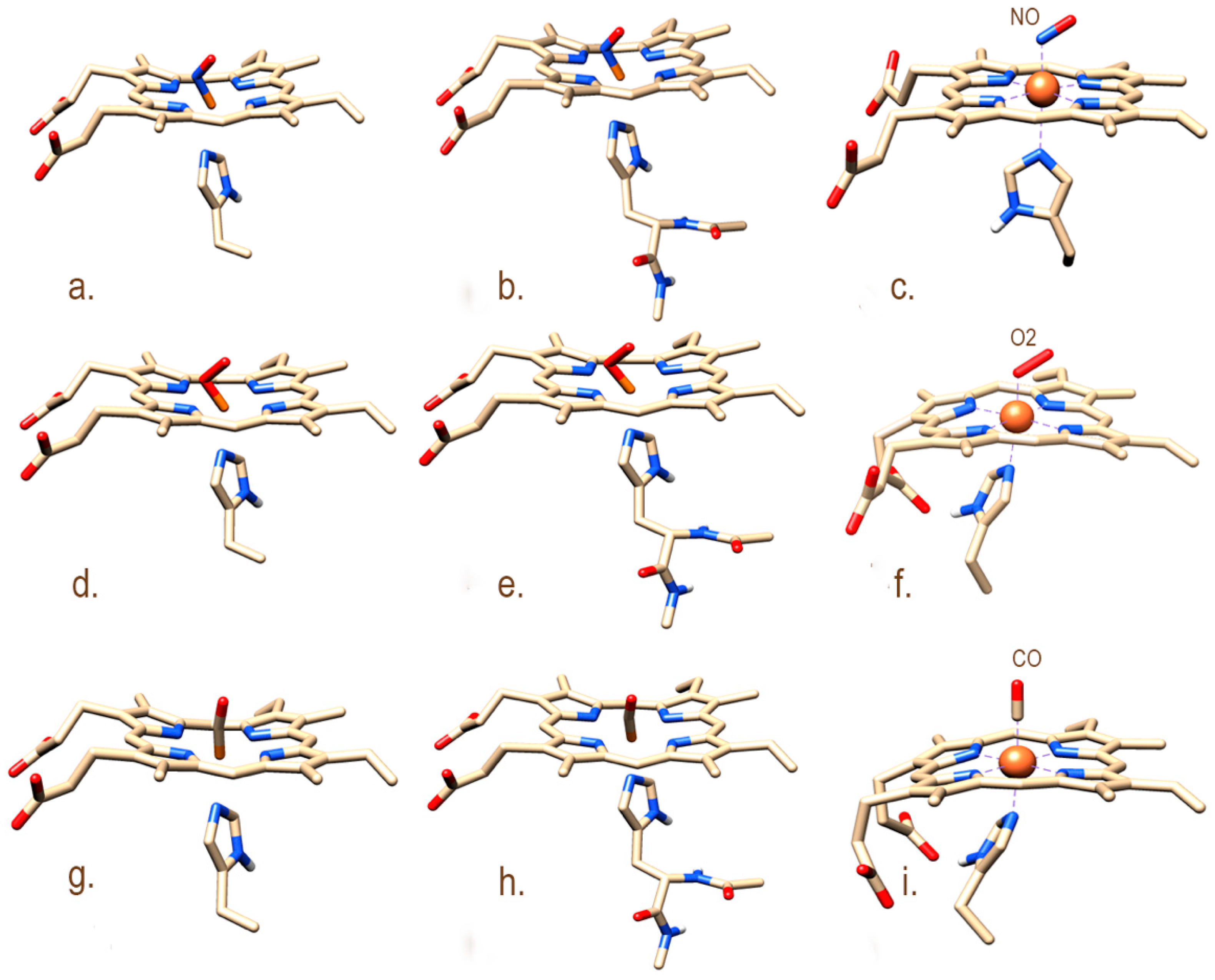
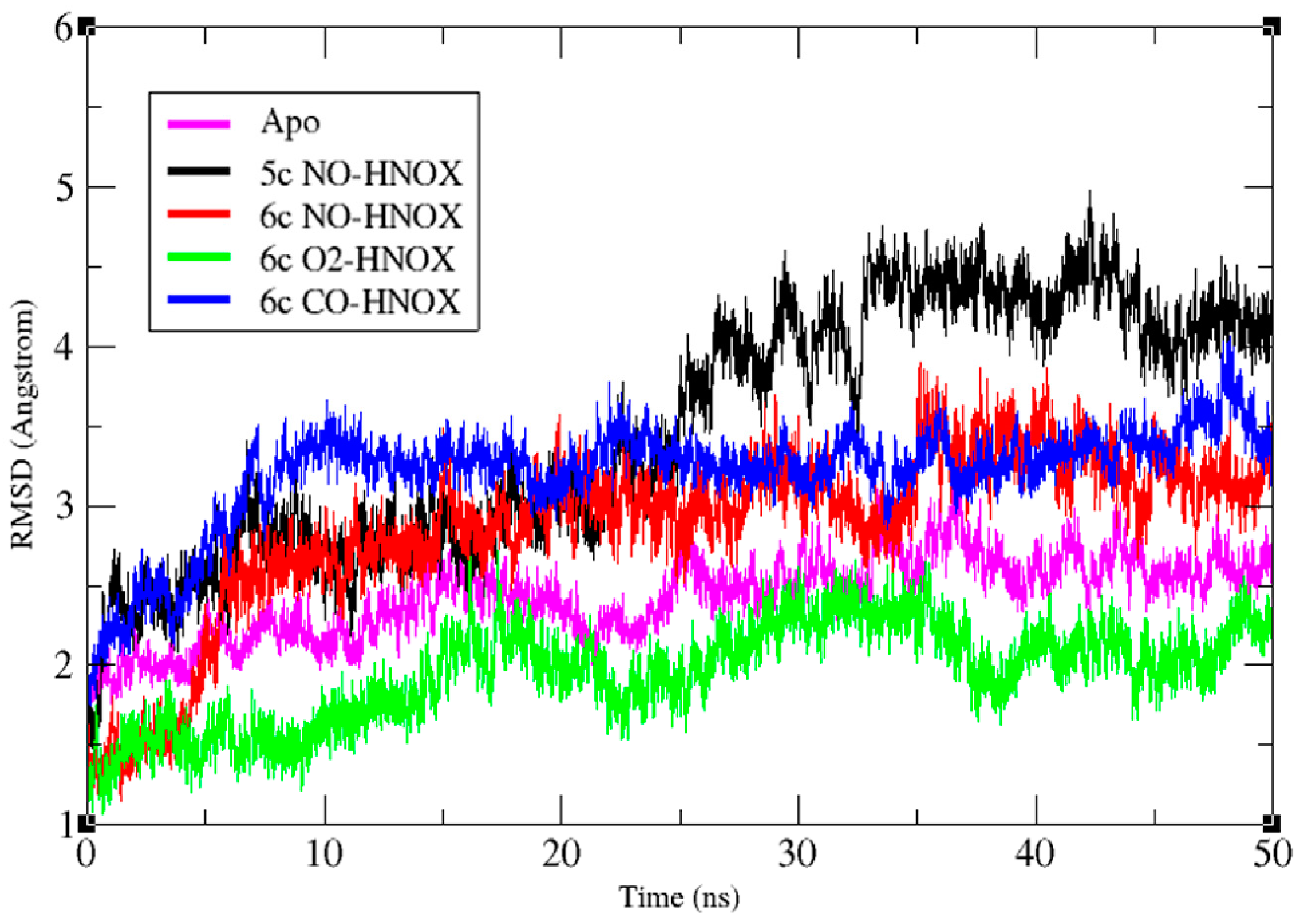

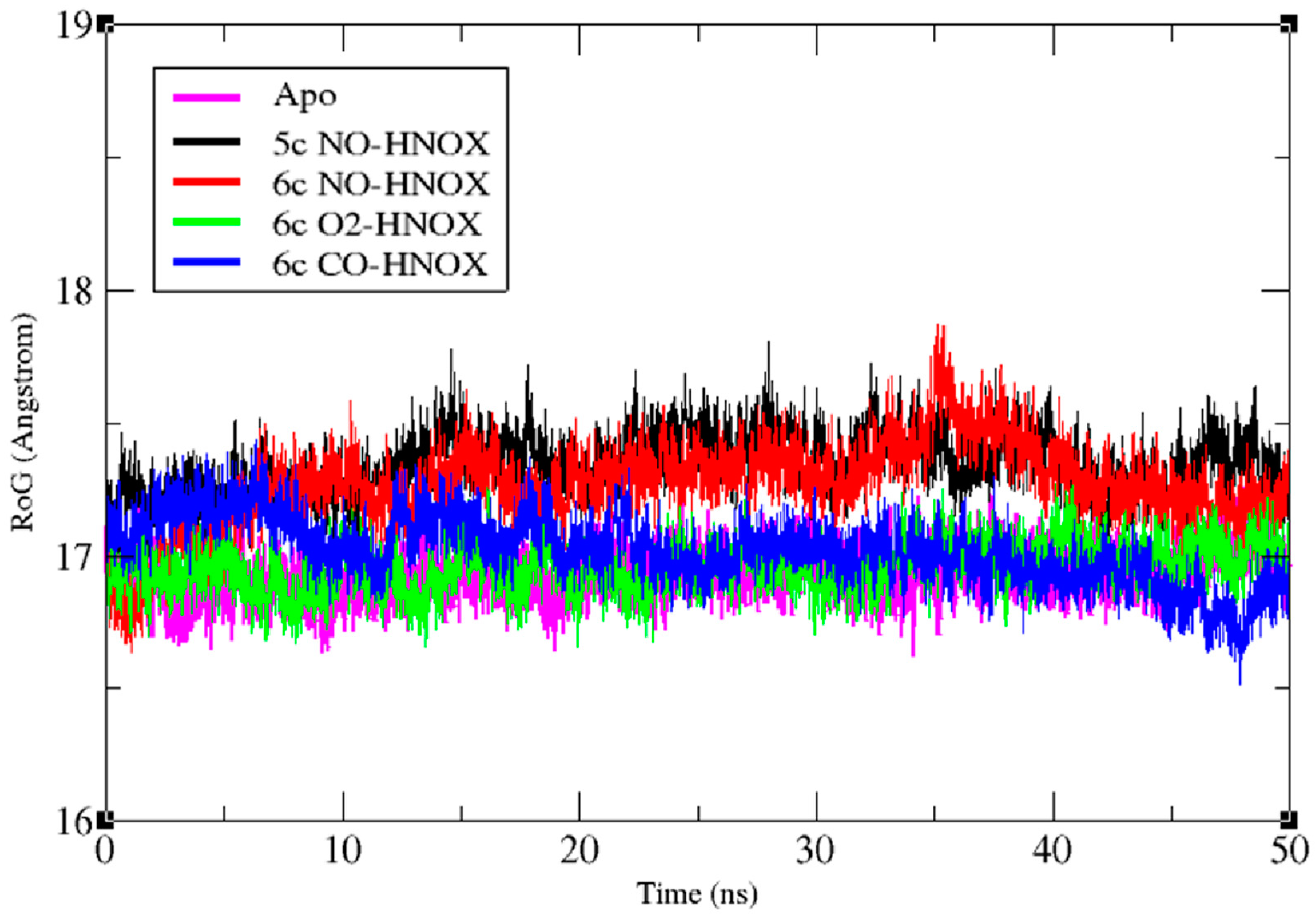
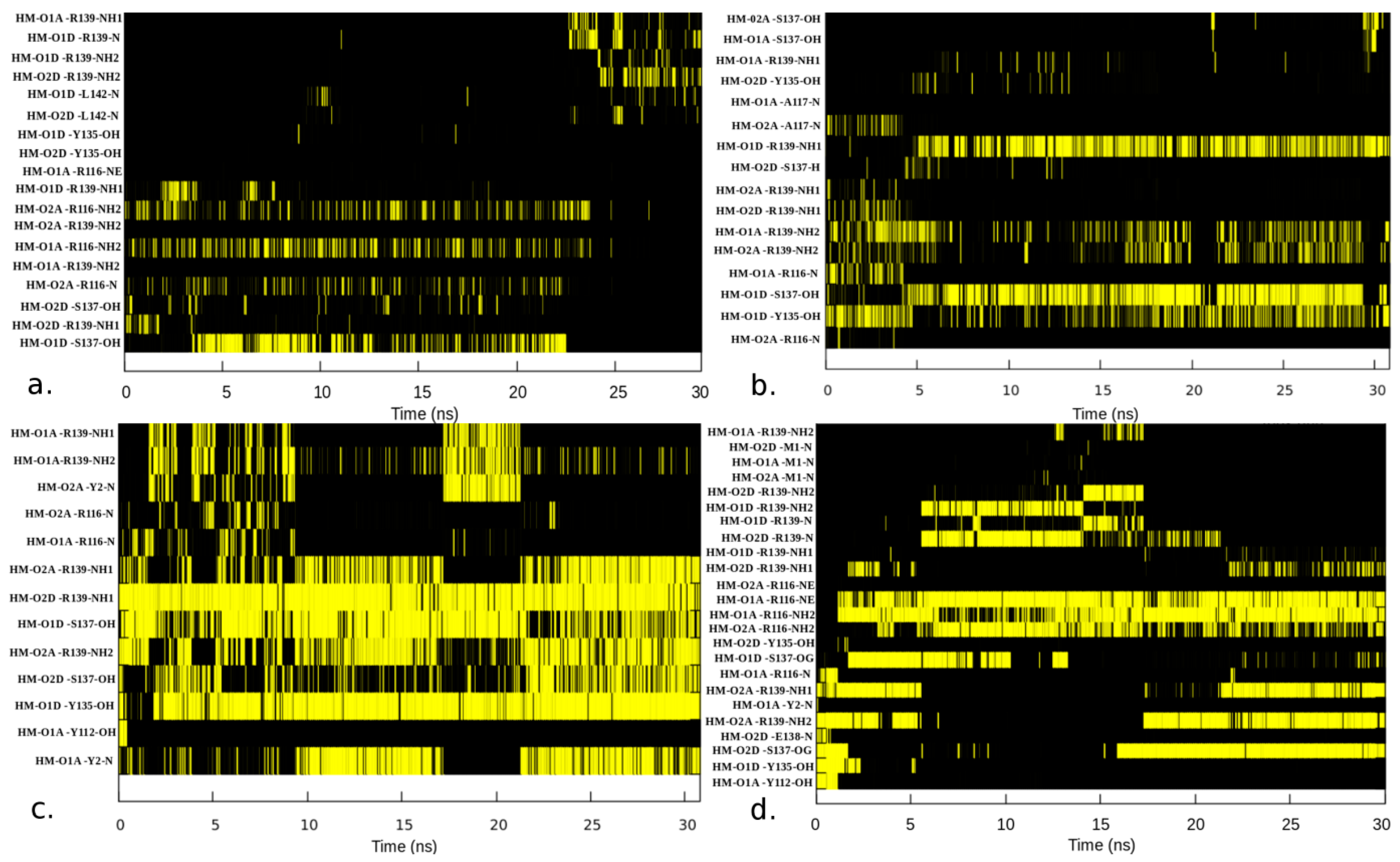
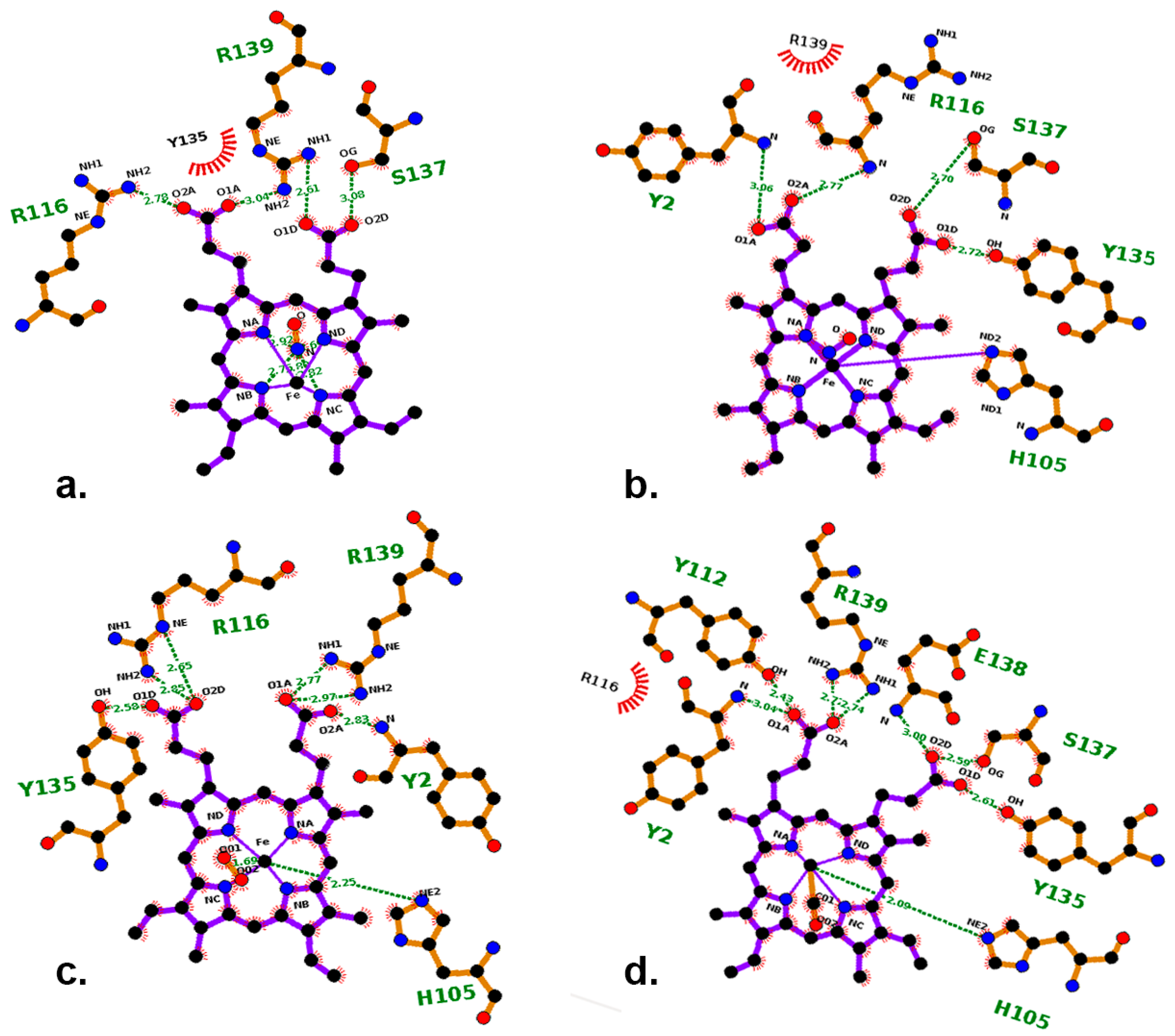


| Complexes | Acceptor | Donor | Percent of Frames of 30 ns Simulation Showing the Hydrogen Bond | Average Distance | Average Angle |
|---|---|---|---|---|---|
| Apo-HNOX | HM-187@O | R139@N | 96.86 | 2.79 | 155.98 |
| HM-187@O | S137@OH | 94.79 | 2.72 | 156.46 | |
| HM-187@O | Y135@OH | 87.41 | 2.70 | 158.41 | |
| HM-187@O | Y2@N | 44.39 | 2.84 | 153.42 | |
| HM-187@O | R116@N | 28.94 | 2.86 | 159.21 | |
| HM-187@O | Y112@OH | 2.06 | 2.76 | 164.44 | |
| 5c HNOX-NO | HM-187@O | R116@N | 54.75 | 2.92 | 145.26 |
| HM-187@O | S137@OH | 35.37 | 2.81 | 150.52 | |
| HM-187@O | R139@N | 30.23 | 2.90 | 149.28 | |
| HM-187@O | L142@N | 4.74 | 2.90 | 155.25 | |
| HM-187@O | Y49@OH | 0.82 | 2.85 | 147.41 | |
| HM-187@O | Y135@OH | 0.18 | 2.84 | 148.21 | |
| HM-187@O | E138@N | 0.07 | 2.89 | 141.79 | |
| 6c HNOX-NO | HM-187@O | R139@N | 96.62 | 2.89 | 145.54 |
| HM-187@O | S137@OH | 72.48 | 2.85 | 150.51 | |
| HM-187@O | Y135@OH | 40.07 | 2.85 | 150.70 | |
| HM-187@O | R116@N | 9.33 | 2.91 | 146.68 | |
| HM-187@O | A117@N | 3.26 | 2.88 | 142.18 | |
| HM-187@O | E138@N | 1.30 | 2.93 | 155.31 | |
| 6c HNOX-O2 | HM-187@O | R139@N | 93.06 | 2.82 | 152.35 |
| HM-187@O | S137@OH | 91.08 | 2.73 | 156.89 | |
| HM-187@O | Y135@OH | 87.66 | 2.69 | 160.04 | |
| HM-187@O | Y2@N | 17.57 | 2.82 | 153.32 | |
| HM-187@O | R116@N | 8.72 | 2.85 | 156.24 | |
| HM-187@O | Y112@OH | 1.34 | 2.73 | 165.64 | |
| 6c HNOX-CO | HM-187@O | R116@N | 90.82 | 2.79 | 155.25 |
| HM-187@O | R139@N | 89.55 | 2.74 | 154.96 | |
| HM-187@O | S137@OH | 82.14 | 2.64 | 165.79 | |
| HM-187@O | Y135@OH | 8.11 | 2.65 | 165.85 | |
| HM-187@O | Y112@OH | 3.66 | 2.56 | 159.99 | |
| HM-187@O | E138@N | 1.46 | 2.85 | 158.29 | |
| HM-187@O | M1@N | 1.19 | 2.78 | 143.47 | |
| HM-187@O | Y2@N | 0.34 | 2.85 | 156.35 |
| Acceptor | Donor | Frames | Fraction | Distance Å | Angle |
|---|---|---|---|---|---|
| L101@O | H105@N | 63780 | 0.8283 | 2.7872 | 163.1623 |
| H105@O | A109@N | 39130 | 0.5082 | 2.8682 | 158.5987 |
| H105@O | L108@N | 4746 | 0.0616 | 2.9051 | 150.2395 |
| P118@O | H105@N | 2749 | 0.0357 | 2.8107 | 155.5122 |
| D102@O | H105@N | 4722 | 0.0614 | 2.8373 | 151.0958 |
© 2019 by the authors. Licensee MDPI, Basel, Switzerland. This article is an open access article distributed under the terms and conditions of the Creative Commons Attribution (CC BY) license (http://creativecommons.org/licenses/by/4.0/).
Share and Cite
Khalid, R.R.; Siddiqi, A.R.; Mylonas, E.; Maryam, A.; Kokkinidis, M. Dynamic Characterization of the Human Heme Nitric Oxide/Oxygen (HNOX) Domain under the Influence of Diatomic Gaseous Ligands. Int. J. Mol. Sci. 2019, 20, 698. https://doi.org/10.3390/ijms20030698
Khalid RR, Siddiqi AR, Mylonas E, Maryam A, Kokkinidis M. Dynamic Characterization of the Human Heme Nitric Oxide/Oxygen (HNOX) Domain under the Influence of Diatomic Gaseous Ligands. International Journal of Molecular Sciences. 2019; 20(3):698. https://doi.org/10.3390/ijms20030698
Chicago/Turabian StyleKhalid, Rana Rehan, Abdul Rauf Siddiqi, Efstratios Mylonas, Arooma Maryam, and Michael Kokkinidis. 2019. "Dynamic Characterization of the Human Heme Nitric Oxide/Oxygen (HNOX) Domain under the Influence of Diatomic Gaseous Ligands" International Journal of Molecular Sciences 20, no. 3: 698. https://doi.org/10.3390/ijms20030698
APA StyleKhalid, R. R., Siddiqi, A. R., Mylonas, E., Maryam, A., & Kokkinidis, M. (2019). Dynamic Characterization of the Human Heme Nitric Oxide/Oxygen (HNOX) Domain under the Influence of Diatomic Gaseous Ligands. International Journal of Molecular Sciences, 20(3), 698. https://doi.org/10.3390/ijms20030698








